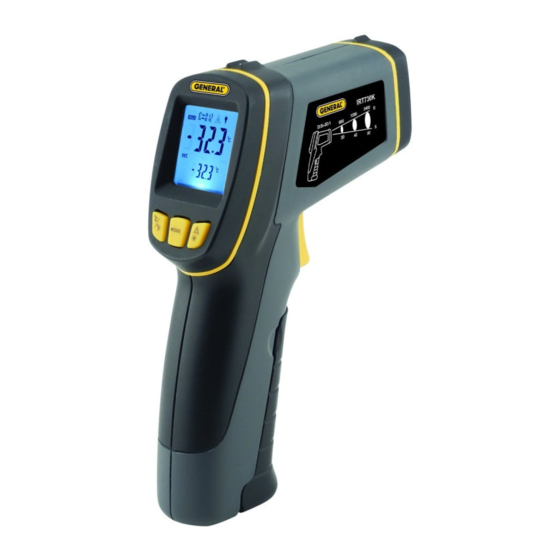
Subscribe to Our Youtube Channel
Summary of Contents for General IRT730K
- Page 1 30:1 ULTRA WIDE-RANGE IR THERMOMETER WITH “K” PORT USER’S MANUAL IRT730K Please read this manual carefully and thoroughly before using this product.
-
Page 2: Table Of Contents
(larger) readout and the maximum, minimum or average measurement, or the largest difference between measurements, during that session on a secondary (smaller) readout. The IRT730K, the “K” type bead thermocouple, a “9V” battery and this user’s manual are packaged in a soft pouch inside a box. -
Page 3: Key Features
SAFETY INSTRUCTIONS CAUTION The IRT730K is a Class 2 laser product that emits less than 1mW of radiation at a wavelength between 630 and 670nm. Avoid looking directly at the laser pointer. U.S. law prohibits pointing a laser beam at aircraft; doing so is punishable by a fine of up to $10,000 and imprisonment. -
Page 4: What's In The Package
WHAT’S IN THE PACKAGE The IRT730K comes in a soft pouch inside a box along with a “K” type bead thermocouple probe, a “9V” battery and this user’s manual. PRODUCT OVERVIEW Fig. 1 shows all controls, indicators, connectors and other physical features of the IRT730K. -
Page 5: Setup Instructions
SETUP INSTRUCTIONS INSTALL BATTERY " The IRT730K’s battery compartment (Fig. 1, Callout 4) is below the measurement trigger and " accessible from the front of the grip. Before installing the “9V” battery included in the package, remove the plastic wrap covering its terminals. -
Page 6: Operating Instructions
OPERATING INSTRUCTIONS USING THE IRT TO MEASURE TEMPERATURE This section describes how to operate the IRT730K in its “normal” mode, with and without use of the backlight and/or laser pointer. In this mode (called REC mode), each measurement made by squeezing the measurement trigger is automatically stored (recorded) in a numerically tagged location in the instrument’s nonvolatile memory. -
Page 7: Choosing An Irt Display Mode
“wake up” the IRT; it typically ends 30 seconds after you have finished making measurements with the activation of the APO function. What the IRT730K can do is display the maximum and minimum temperatures recorded during a measurement session. It can even calculate and display the average reading and the difference between the highest and lowest readings. -
Page 8: Adjusting Emissivity And Setting Temperature Alarms
0.10 and 1.00 in steps of 0.01. The default (factory setting) of is 0.95. Because the IRT730K measures the amount of infrared energy emitted by a surface, its measurements are most accurate when they take into account the characteristic emissivity of the target material. -
Page 9: Recalling Stored Readings
HAL setpoint. The Low Temperature Alarm is activated when the temperature measured by the IRT is lower than the LAL setpoint. In each case, the IRT730K responds by sounding a second chirp (following the usual first chirp to indicate that a measurement was made and stored) and flashing an icon on the bottom line of the LCD (Fig. -
Page 10: Using The "K" Type Probe To Measure Temperature
(or another “K” type probe): 1) Plug the two prongs of the probe into the two slots on the bottom of the IRT730K. Be sure to insert the slightly narrower (+) prong into the slightly narrower slot, which is closer to the rear of the unit. -
Page 11: Specifications
D:S ratio of 30:1 enables narrow measurement of high-temperature objects (up to 1472ºF/800ºC) from a safe distance. To eliminate measurement error, move the IRT730K close enough to the target so the circle created by the targeting laser falls just within the object being measured. See Appendix II for a brief tutorial: How to Make Accurate IR Temperature Measurements. -
Page 12: Warranty Information
Acceptance of the exclusive repair and replacement remedies described herein is a condition of the contract for purchase of this product. In no event shall General be liable for any incidental, special, consequential or punitive damages, or for any cost, attorneys’ fees, expenses, or losses alleged to be a consequence of damage due to failure of, or defect in any product including, but not limited to, any claims for loss of profits. -
Page 13: Return For Repair Policy
The IRT730K’s field of view HOW TO MAKE ACCURATE IR MEASUREMENTS The IRT730K has a distance-to-spot (D:S) ratio of 30:1. This means that the target area (spot) whose infrared radiation (temperature) is being measured increases in diameter by 1 inch for every 30 inches you move away from the target. Conversely, the diameter of the target area measured decreases by 1 inch for every 30 inches you move closer to the target. - Page 14 Tavg = (Tmotor + Tbackground) ÷ 2 Solving for Tavg, we get (200 + 75) ÷ 2 or 137.5°F., which is what the IRT730K would display. In other words, trying to measure the temperature of the motor from 60 ft.
-
Page 15: Appendix Ii. Emissivities Of Common Materials
APPENDIX II EMISSIVITIES OF COMMON MATERIALS Material Emissivity Material Emissivity Aluminum 0.30 Glass 0.90 to 0.95 Asphalt 0.95 Iron Oxides 0.78 to 0.82 Concrete 0.95 Paint 0.80 to 0.95 Asbestos 0.95 Plastic 0.85 to 0.95 Ceramics 0.95 Paper 0.70 to 0.94 Brass 0.50 Plaster... - Page 16 New York, NY 10013-3567 PHONE (212) 431-6100 FAX (212) 431-6499 TOLL FREE (800) 697-8665 e-mail: sales@generaltools.com www.generaltools.com IRT730K User’s Manual Specifications subject to change without notice ©2013 GENERAL TOOLS & INSTRUMENTS NOTICE - WE ARE NOT RESPONSIBLE FOR TYPOGRAPHICAL ERRORS. MAN# IRT730K 10/24/13...
















Need help?
Do you have a question about the IRT730K and is the answer not in the manual?
Questions and answers